Talent Development Leaders play an essential role in helping their team develop soft skills (human skills) by sharing time-testing learning and concepts. This information provides foundational knowledge and skills that are essential for employee growth. However, one of the ongoing challenges in learning and development is ensuring that the valuable insights gained from these sessions are retained and effectively applied in everyday work.
We have access to more information than ever before, yet the changing nature of work, pressing problems to solve, and focus on productivity can quickly outpace the ability to retain new learning. Even before these more modern challenges made it harder to focus and acquire knowledge, there were models about learning that showed a typical erosion of knowledge days after learning. The human mind can only process a limited amount of information, most of which never makes it to long-term memory.
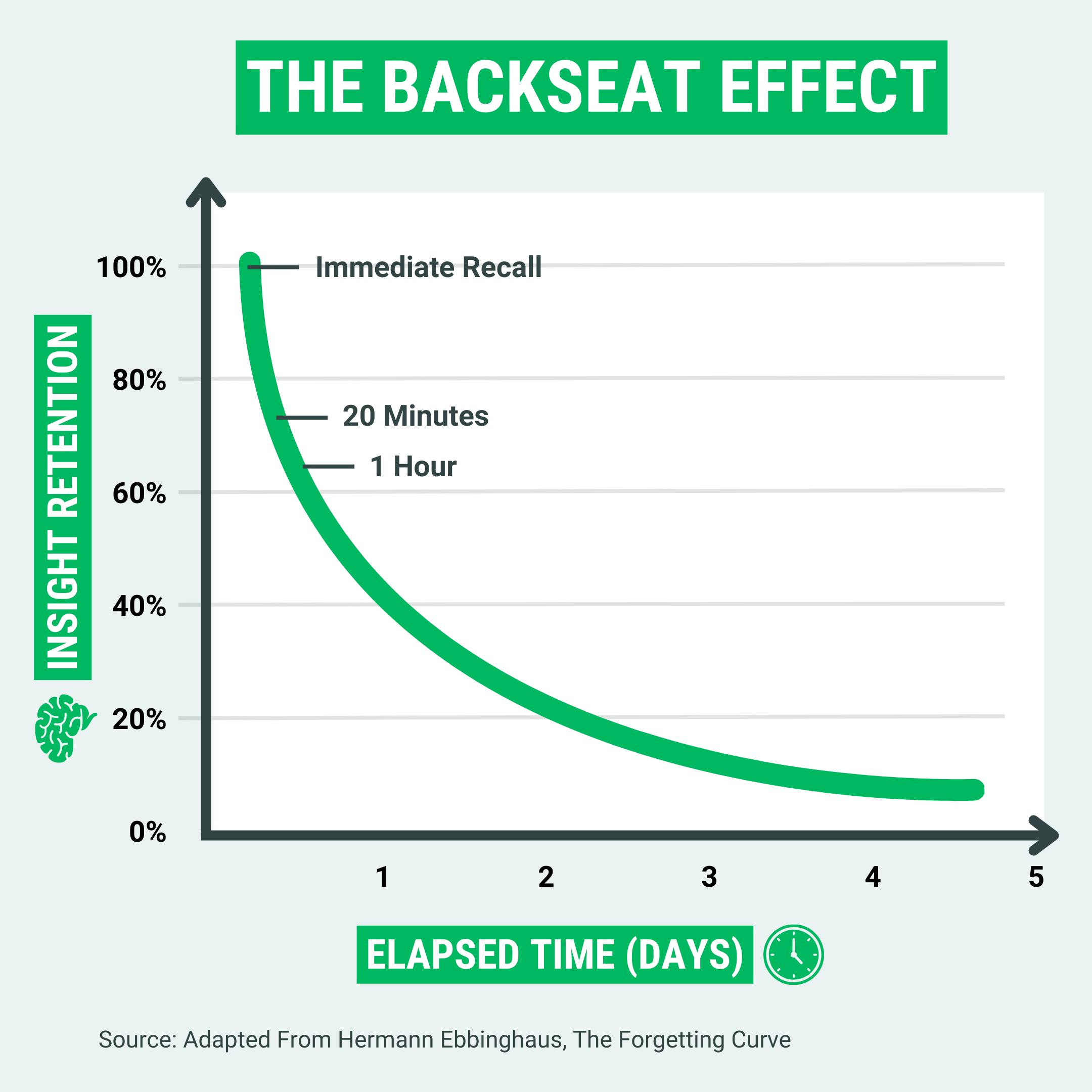
Does Learning and Development Need To Adapt?
Learning methods provide so much valuable information, but how do you make it stick? Training often involves ongoing sessions, but what about when these are not available or happening? Learners may forget or struggle to apply.
This was famously measured and proven by one of the most influential early experiments in psychology. Between 1880 and 1885, Hermann Ebbinghaus studied how much information can be retained after specific intervals of time. He found that within 20 minutes of studying new information, 40% is already forgotten, rising to nearly 70% by the end of that first day (Murre & Dros, 2015). This study has since been replicated numerous times, all with similar results, and that is after studying information with intentional attempts to remember it.
The approach to development is ripe for change so that it can align with how our brains process and retain information.
Enter the concept of micro-nudges, an approach to learning and development that seamlessly integrates into the daily workflow of employees. Micro-nudges are brief, focused prompts that facilitate continuous learning and improvement without the cognitive overload associated with traditional methods.
Nudges can leverage contextual, situational prompts to encourage behaviors and actions that align with organizational goals and individual development paths. Providing small, digestible pieces of information right when they are most relevant enables a more natural and effective understanding and application of new knowledge.

HUMAN SKILL PROGRAMS ARE HITTING LIMITATIONS...
5 THINGS THIS FREE RESOURCE WILL TEACH YOU
- Close the widening gap between learning and on-the-job application
- Overcome the tension of pausing productivity for development opportunities
- Integrate learning so it is actually in the flow of work
- The evolution of human skill development
- What Automated Coaching™ is and how it works.

Why Are Micro Nudges More Effective For Employees?
Micro-nudges represent a tailored solution to the challenges traditionally associated with learning and development, particularly the problems of information overload and rapid forgetfulness post-training. By addressing these issues head-on, micro-nudges enhance the learning experience, making it more effective and impactful.
Consider what it’s like to use some of the most popular strengths and behavioral assessments such as Myers-Briggs®, DISC, CliftonStrengths®, or Enneagram. Most assessment results are delivered as an overwhelming, one-time data dump in the form of a 30-page PDF report.
Most people will say they gleaned a key epiphany about themselves but can’t remember their result type. One epiphany is helpful, but 99% of the value is lost.
This happens so often that the trade has a nickname for this problem—the backseat effect—whereby detailed assessment reports are never fully internalized and tossed into the backseat of one’s car. Not because the reports aren’t thoughtfully constructed or lack insight but because they are simply too much information to handle at once.
A better approach entails using automated micro-nudges, where actionable insights are delivered in small doses over a long period of time. For example, Automated Coaching™ uses this approach by delivering assessment-derived recommendations via organizational communication channels (e.g., email, Slack, Teams) on how employees should approach their tasks or interactions with teammates.
Nudges can transform hard-to-retain information into an integrated learning process that aligns with the principles of how people best learn and adapt.
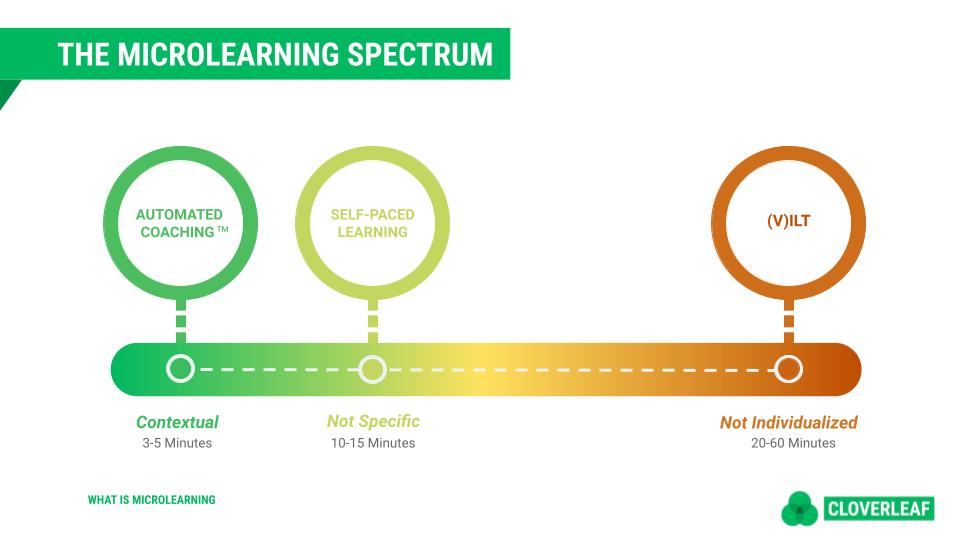
Are Nudges The Solution To The Challenges Of Human Skill Development?
1. Soft Skill Development Is A Dynamic Process
There is an assumption that soft skill development is sequential and upward, whereby individuals start at a lower level of competency and progress towards a pinnacle destination. While this scaffolding approach works for technical skills, it breaks down for soft skills.
The process of soft skill development is fluid—you start in situ, with varying levels of competence across an ever-evolving list of knowledge, skills, and abilities that matter in some contexts but not others (Day & Dragoni, 2015). Therefore, when it comes to developing human skills, it must move from a static experience to a dynamic experience.
Nudges provide timely, situational guidance that allows individuals to apply and refine these skills in real-time, adapting to the evolving demands of different workplace scenarios.
2. Soft Skill Development Must Be Highly Personalized
Organizations typically approach soft skill initiatives as if everyone is similar with respect to their psychographics (e.g., traits, strengths, cognitive abilities, worldviews, etc.) and their interest in development in general (e.g., motivation to learn, leader identity, self-efficacy). While designing for the mean is efficient, it’s not effective. The goal, instead, should be to assume variability across individuals (Rose et al., 2013) and, in turn, move from overgeneralized insights to personalized insights.
For example, Automated Coaching counters this problem by offering personalized insights tailored to the unique psychographics of each individual, such as their traits, strengths, and cognitive abilities. By integrating data-driven insights into personalized nudges, learners receive specific, relevant guidance that respects their individual differences and developmental needs.
3. Soft Skill Development Must Be Actionable
Soft skill development typically happens as a one-time initiative (e.g., workshop, training, coaching session, etc.) where participants are inundated with recommendations. This approach is misaligned with information processing theory, which suggests that human beings can only process and retain a limited amount of information in one setting (Atkinson & Shiffrin, 1968).
Nudges address this challenge by breaking down information into smaller, manageable insights delivered at the point of need. To fully optimize developmental resources (e.g., time, money, energy) necessitates an approach that moves from being overwhelming to one that is digestible and actionable.
Nudges Can Make Human Skill Development A Light Lift For Leaders
In total, the problem is that soft skill development is currently a static, overgeneralized, and overwhelming experience but should instead be a dynamic, personalized, and actionable experience.
Micro-nudges are promising given that research suggests that learning and behavior regulation are optimized when the experience is customized to individuals’ characteristics and needs, situationally adaptive, integrated within one’s flow of work, and available on demand (Maity, 2019). Human beings can’t accommodate these features at scale, but technology-derived micro-nudges certainly can (Kurzweil, 1990).
Those in charge of assessments need to be realistic. People can’t internalize information like super-computers. The goal should be to deliver digestible nuggets of information at the right time and in the right place. Addressing individuals’ specific needs and contexts, micro-nudges help transform the approach to soft skill development from a burdensome task into a series of manageable, impactful interactions that promote sustainable growth and meaningful engagement in the workplace.
Proven Behavior Change Through Coaching Nudges
One of the most compelling validations for the use of micro-nudges in talent development comes from recent research findings associated with Automated Coaching™. Studies have shown that micro-nudges significantly boost self-reflection, enhance the desire for self-knowledge, and improve the capability to handle complex challenges.
Impact on Self-Reflection and Self-Knowledge: Micro-nudges are specifically designed to prompt individuals to think critically about their immediate actions and how these align with their longer-term goals and professional growth. This continual engagement not only reinforces learning but also fosters a deeper understanding of one’s strengths and areas for improvement.
Enhancing Capability to Handle Challenges: By providing real-time, contextual feedback, micro-nudges empower employees to apply soft skills in various situations, from resolving conflicts to collaborating effectively with diverse teams.
Contextualized Nudges Make Scaling Human Skills A Real Possibility
One of the most significant advantages of micro-nudges is their ability to provide real-time, contextualized feedback. This type of feedback is crucial because it ties directly into the immediate tasks or challenges employees face. By integrating learning directly into the flow of work, micro-nudges ensure that training is not only more relevant but also immediately applicable.
Moreover, micro-nudges allow for a dynamic learning experience that evolves with the needs of the employee. Automated Coaching is designed to deliver information in a way that the human brain best processes and retains data: little by little and just at the right time.
The effectiveness of micro-nudges is also evident in their capacity to encourage behaviors and actions that align with organizational goals and individual development paths. By providing small, digestible pieces of information at critical moments, micro-nudges enable a more natural and effective understanding and application of knowledge, which is vital for personal growth and organizational success.
In today’s rapidly evolving workplace, businesses constantly strive to improve employee performance and foster a motivating coaching culture. One emerging trend in achieving this goal is the use of Automated Coaching.
But why is Automated Coaching™ so valuable? As businesses aim to provide targeted and impactful coaching, they face challenges in developing effective training programs tailored to employees’ needs.
By leveraging data-driven insights and personalized coaching, organizations and teams can effectively identify skills gaps, develop tailored training programs, and drive learning and development initiatives aligning with organizational goals.
Let’s dive into what Automated Coaching™ is and discover why it’s quickly becoming an essential component of leadership development in the modern workplace.
Key Takeaways:
- Despite numerous L&D initiatives, employee behavior is only modestly impacted.
- Optimized learning occurs when the experience is customized, integrated into the workflow, and available on demand.
- Automated Coaching™ offers relevant, real-time prompts for improved emotional intelligence, communication, collaboration, and conflict resolution.
- Employees require smaller, well-timed insights that can be processed and applied daily for growth.
- Automated Coaching™ can scale to provide development opportunities for all employees.
The Problem with Traditional Learning and Development Initiatives
Leadership and development (L&D)—the process of helping employees increase performance and well-being in organizational settings—is a $366B industry. L&D is everywhere, with larger organizations having in-house L&D departments/positions, Universities offering L&D-specific degrees (e.g., master’s degrees, executive education), dozens of the world’s largest consulting firms specializing in L&D offerings, and hundreds of thousands of small businesses and solopreneurs engaging in L&D through individual and team-based coaching and consulting.
The problem, however, is that despite the sheer magnitude of L&D interest and initiatives, meta-analytic evidence suggests that its impact on employee behavior is relatively modest.
The source of the issue is that learning and development typically manifest as a one-time initiative where participants are inundated with recommendations. This approach is misaligned with the fact that human beings can only process and retain a limited amount of information in one setting. Further, L&D is typically delivered as a pre-packaged and static offering, which overlooks that individuals are different and that their priorities, careers, and lives are constantly in flux.
Research suggests that learning and behavior regulation are optimized when the experience is customized to users’ characteristics and needs, integrated within one’s workflow, and available on demand. Human beings can’t accommodate these features at scale, but technology certainly can. This is where Automated Coaching™ can make a substantial impact.

HUMAN SKILL PROGRAMS ARE HITTING LIMITATIONS...
5 THINGS THIS FREE RESOURCE WILL TEACH YOU
- Close the widening gap between learning and on-the-job application
- Overcome the tension of pausing productivity for development opportunities
- Integrate learning so it is actually in the flow of work
- The evolution of human skill development
- What Automated Coaching™ is and how it works.
Automated Coaching: The Evolution in Self-Directed Growth and Development
Traditional coaching entails the dyadic relationship between coach and coachees, which involves a process of collaborative goal-setting, constructing solutions, and fostering the coachee’s self-directed growth.
With Automated Coaching™, the goal is pre-defined (i.e., enhancing self-awareness and other-awareness), and the automated coaching system generates solutions that foster the coachee’s self-directed growth. In turn, Automated Coaching™ provides relevant, in-the-moment prompting and insight that individuals can directly apply to increase emotional intelligence, strengthen communication, identify opportunities for collaboration, and work through conflict successfully with teammates.
Cloverleaf uses assessment data to provide digital nudges to everyone within a team or organization to improve performance, increase managerial effectiveness, strengthen cross-functional collaboration, and inspire personal development.
A consolidated dashboard provides insights into employee strengths, weaknesses, and areas for improvement. From validated personality and strengths assessments to daily coaching, this approach can help organizations improve collaboration, strengthen performance, and better understand the needs of their teams.
How Automated Coaching™ is Revolutionizing Daily Growth and Development in the Workplace
One of the advantages of Automated Coaching™ is that it can be “pulled” at the coachees’ convenience and that it can be “pushed” every day, as many times as the system is programmed. Thus, unlike other L&D opportunities, Automated Coaching™ can facilitate coachee growth on a day-to-day basis. This approach aligns with several theories in organizational behavior.
First, according to social learning theory, human beings can only attend to, process, and retain a limited amount of information. Said differently, people can’t internalize information like super-computers. If organizations want their employees to grow, they must deliver smaller, digestible, well-timed insights that they can process and apply daily.
Second, research is being conducted in clinical psychology on using “micro-interventions”–small and short interventions void of human contact–that help patients with anything from anxiety to addiction.
These microlearning interventions align with what’s called metacognitive prompt theory, which suggests that you can nudge people to be more aware of their situation through purposeful reflection, which leads to more heightened self-regulation and behavior change.
Cloverleaf has researched this phenomenon, and the results are promising. The extent to which users engaged with the automated coaching program positively impacted several important outcomes, including an enhanced desire to learn more about themselves and their work, improved interactions with team members, and an overall better mood while at work.
Will Automated Coaching™ Replace Or Support Traditional Coaching Practices?

Automated Coaching™ will supplement, not replace, traditional coaching. Prior research illustrates that, when done well, coaching increases coachee performance and well-being.
Automated Coaching™ give coaches a more efficient method for staying connected with their coachees. It also gives them richer material to discuss with their coachees. In an ideal world, employees have access to both.
Unfortunately, many don’t experience the benefits of coaching, given the cost, lack of access, or time commitment. Technology can help close this gap by lowering costs and making coaching more scalable and widely available to diverse groups.
Is Automated Coaching™ The Same Thing As Artificial Intelligence?
Automated Coaching™ is broader than artificial intelligence (AI). However, where appropriate, AI can play a fundamental role in helping make Automated Coaching™ more adaptive and impactful.
We are far from “strong AI,” whereby machines are fully autonomous with general intelligence. Indeed, AI is making substantial process over the last decade, making it easier for organizations to incorporate into products like Automated Coaching™. However, applying “weak AI,” whereby specific algorithms are embedded to solve particular problems, is more representative of what coaching and Automated Coaching™ have the potential to incorporate in the short term.
How Can Leaders Rethink What's Possible With Coaching for Today's Workplace
Traditional coaching strategies have shortcomings that can be felt across an organization. However, scaling the development of team members is more tangible today.
As outlined here, there are four significant challenges to traditional coaching models that hinder their effectiveness in the workplace:
- It is often limited to the coachee’s perspective
- Providing a human coach is costly
- Relevance and timeliness are limited due to scheduling
- Proving impact that affects organizational results
As such, innovation is needed to address these challenges related to organizational training and development. Automated Coaching™ overcomes the challenges leaders are familiar with in delivering coaching to their employees.
Automated Coaching Is:
- Scalable
- Timely
- Measurable
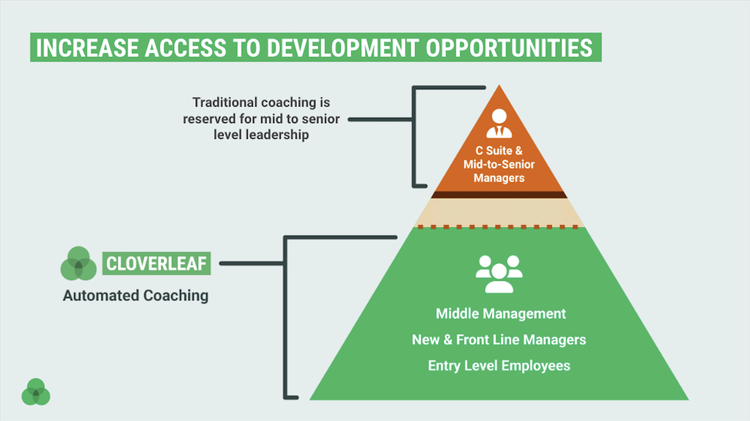
Unlike traditional coaching models, Automated Coaching™ can scale to increase access to development opportunities for everyone in an organization. This means that employee coaching is no longer limited to a select few but can widely extend throughout a company.
What’s more, Automated Coaching™ provides employees with a greater number of coaching moments than traditional practices. Instead of relying on monthly sessions where individuals hopefully gather a handful of understanding, Automated Coaching™ integrates into the user’s workday to offer in-the-moment, relevant insights and tips.
Additionally, Automated Coaching™ offers a unique advantage in the form of user feedback, allowing individuals to provide input on the coaching tips they receive. This immediate feedback response enables users to obtain better insights and more applicable coaching tailored to their specific growth. Therefore, Automated Coaching™ can adapt to the needs of each individual, making it a powerful tool for employee development and organizational performance.
Final Thoughts
As businesses seek new ways to streamline training and deliver impactful coaching, Automated Coaching™ provides a unique solution. With the ability to adapt to the specific needs of individuals, it is a powerful tool for employee development and organizational performance.
The future of leadership development lies in this customized, on-demand coaching that can enhance skills and increase performance, transforming the workplace for years to come.
Coaching in the workplace is a powerful tool that can help employees reach their full potential and maximize their performance. It provides employees with feedback, guidance, and support to help them reach their goals.
Coaching is one of several investments companies can make toward developing their people. This concept often falls under the broad umbrella of learning and development. This can include mentoring, training, and career planning.
What Is Coaching In The Workplace
Coaching in the workplace is a collaborative and empowering approach where the leader acts as a “thinking partner.” This strategy helps employees self-discover to reach their goals and objectives. Therefore, coaching differs from giving orders or dictating how the employee should work. This approach allows employees to take ownership of their development and feel more motivated and engaged.
Key Takeaways:
- Leaders who coach are thinking partners to collaborate rather than dictate.
- A coaching approach can help employees take ownership of their development and feel more motivated and engaged in their work.
- Asking questions can help leaders coach teammates more effectively.
- A coaching culture can support a positive environment and foster growth
- Each situation and employee is unique.
How Is Coaching Employees Different From Traditional Management
3 Ways Coaching Is Different From Other Management Strategies:
- Coaching focuses on discovering rather than controlling
- Leaders who coach are thinking partners to collaborate rather than dictate
- A coach is goal-oriented rather than process oriented
One big difference is that coaching focuses on helping employees develop their conclusions to reach their goals, rather than simply managing their tasks and work output.
This means that a coach will work with an employee to identify areas for improvement, set goals, and create a plan to achieve those goals by serving as a thinking partner rather than commanding and controlling every step.
Coaching is a more collaborative and empowering approach. Therefore, leaders who act as coaches work with employees as partners rather than giving them orders or dictating how they should work. This approach helps employees to take ownership of their development and feel more motivated and engaged in their work.
Coaching leads to success because it facilitates psychological capital, a positive psychological resource that coachees can apply to their day-to-day work experiences. – psychologytoday.com
Traditional management often solely focuses on improving the team or organization’s performance. Coaching focuses on helping individual employees self-discover and reach their potential.
A coach will help employees to set and achieve goals, whereas a manager will focus on maintaining processes and procedures.

How To Implement Coaching In The Workplace
Companies continue to increase their investment in coaching as a leading form of developing their talent. Recent studies indicate that 9 out of 10 companies plan to increase their investment in coaching over the next 12 months.
Coaching can happen with trained professionals contracted from outside your organization, or they could be dedicated professionals that work inside the organization (often in HR or Talent Management groups), or it can be managers acting as coaches by using a coaching approach.
A recent Harvard Business Review Article advocates that successful leaders are great coaches by discussing this concept and urging for leaders to act as coaches.
You can introduce Automated Coaching™ to your team by incorporating the Cloverleaf Team Dashboard into your daily workflow. This will help you and your team gain helpful insight about one another and coaching tips to increase understanding, collaboration, and performance.

HUMAN SKILL PROGRAMS ARE HITTING LIMITATIONS...
5 THINGS THIS FREE RESOURCE WILL TEACH YOU
- Close the widening gap between learning and on-the-job application
- Overcome the tension of pausing productivity for development opportunities
- Integrate learning so it is actually in the flow of work
- The evolution of human skill development
- What Automated Coaching™ is and how it works.
How To Develop Skills To Be A Better Coach As A Leader
While coaching may come more naturally to some leaders than others, there are effective ways that everyone can try to hone their coaching skills to be a more collaborative teammate.
Below are some of the best questions and prompts for leaders to ask when they are seeking to help coach a team member.
- Tell me about your goals and objectives.
- What are your strengths and weaknesses?
- Describe the challenges are you currently facing.
- What resources or support do you need to achieve your goals?
- How can I best support you?
- What do you think should be our next steps?
- What are your thoughts about how I help you to improve?
- How do you feel about your current progress?
- How do you think this situation could have been handled differently?
- What are your thoughts on your role in the team?
It’s essential to be flexible, adaptable, supportive and encouraging in your coaching approach.
When coaching team members, leaders should ask questions that focus on the following:
- Identifying goals and objectives
- Strengths and weaknesses
- Challenges
- Resources or support needed to achieve goals.
Asking questions that empower employees to take ownership of their development, reflect on past experiences, and learn from them and their role in the team can also be insightful.
Examples Of Successful Coaching Moments At Work
Unfortunately, it isn’t enough to believe coaching is valuable. Managers and leaders need not only to know how to coach but also to match the coaching technique and approach with the needs of their people. And people are complicated with needs that are unique and varying.
Below are several examples of coaching scenarios to help you better understand how each situation is unique and why the needs of each team member are different.
1. A SALES MANAGER STRUGGLING TO CLOSE DEALS
An experienced sales manager has been struggling with closing high-value deals. The manager’s leader works with them by asking questions to help identify their specific challenges, such as a lack of confidence in their pitch or difficulty building trust with potential clients.
Together, they set goals to improve the sales manager’s communication skills and create a plan to practice and build their confidence. Through regular one-on-one sessions, the leader seeks to help the manager discover practical ways to close more deals and exceed their sales targets.
2. A NEW EMPLOYEE IS STRUGGLING TO ADJUST TO THE COMPANY CULTURE
A new employee is having difficulty adjusting to the company’s culture and workflow. Their leader identifies a project they can work together on to help better understand their strengths and weaknesses.
The leader helps the new employee to create specific goals by asking them what actions they believe are most important to help support the team’s overall objective. The leader also provides consistent input on the employee’s progress by focusing on the goal rather than the process of completing it.
3. A Team Leader Faces Communication Challenges During Remote Work
A team leader is responsible for managing a remote team. The team leader’s boss asks questions to help clarify what is currently working and where there are challenges. Identifying these pain points has helped the team leader discover which areas to address first.
There are tremendous impacts of incorporating coaching in the workplace. Still, organizations often only roll out models or methodologies for coaching. They may even provide some basic training on effective coaching. However, this often stops short of providing valuable tools that help managers and leaders coach the individual needs of their employees.
Why Is Coaching So Important In The Workplace
Coaching in the workplace can significantly impact employee performance and development because it empowers them to self-direct and discover ways of working that lean into their strengths.
Leaders can help team members better understand their strengths and weaknesses and prioritize personal development in the workplace, leading to greater job satisfaction and employee retention.
Additionally, coaching can support a positive work culture and foster a sense of growth and development among the employees, which can significantly benefit the organization.
5 Benefits Of Utilizing Coaching In The Workplace
1. Improved Performance
Coaching can help employees identify areas of improvement and set goals for themselves, which leads to improved performance. Coaching also helps employees stay focused and motivated to reach their goals, providing the necessary support and feedback to help them get there.
2. Increased Morale
Coaching in the workplace can help create a positive working environment and increase morale. Employees who receive feedback and support from their leader are more likely to feel motivated and engaged.
3. Improved Communication
Coaching helps teammates develop communication skills and express their ideas and thoughts effectively. Strengthening this skill can help build strong relationships between team members, even in remote collaboration environments.
Coaching can help employees learn how to manage and resolve conflicts at work effectively. Reducing stress and creating a more productive work environment make for a happier workplace.
5. Increased Retention
Coaching can help employees feel valued and appreciated. This can help improve employee retention rates and create a happier and more productive workplace.

Coaching in the workplace is an invaluable tool that can help employees reach their full potential and maximize their performance. It provides employees with the necessary guidance, feedback, and support to help them reach their goals and succeed.
Next Steps To Provide More Coaching At Your Place Of Work
As an enterprise leader, just believing or saying that coaching is an integral part of your learning and development investment is like asking your managers to be a carpenter but not giving them a hammer and nails.
Cloverleaf can be the tool that is an essential part of any manager’s toolkit. A perfect example of this is recognition. Some team members may need public recognition- this could happen by giving a shout-out at an all-team meeting, a mention on the company website, or a shared channel in Slack.
Other team members may want a more private, personal recognition. This could include a simple email, handwritten note, or MS Teams message that indicates you saw their contribution in the meeting and appreciated it.
Knowing these differences and how to use them for the right person in the right situation is the key to effective coaching, and Cloverleaf can provide you that insight daily within the tools you use every day.
Start a free trial today to learn more, discover its features, and experience the power of coaching at your workplace.
Finding satisfaction in your career has become harder with the changing work landscape and a constant buzz of social media notifications. Companies are moving towards initiatives that include new and foreign hour structures, virtual meeting styles, digital workspaces, and more. For many, developing these new skills can be overwhelming.
Job coaching has come a long way from the days of fluorescent-lit rooms with slide screen presentations. Now, with new technologies and modern connectivity at our fingertips, learners have an opportunity to step out of those well-lit rooms and into a sunnier digital space of personalized, quality-driven, job coaching.
What is Job Coaching?
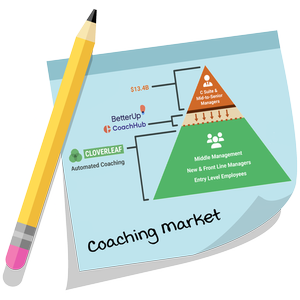
Job coaching comes in many forms and plays an important role in creating interconnected teams, improving employee communication and interpersonal skills, increasing work awareness, and understanding others’ needs alongside one’s own. From executive officers to new hires, there is a spot for everyone but not everyone has taken advantage of these new opportunities. Let’s go over some differences in coaching styles and see some ups and downs.
What is Executive Coaching?
Executive coaching or executive development is an agglomerate phrase and a well-known term covering several mentoring subcultures. From one-on-one mentoring to executive seminars, these coaching styles focus on educating the top of a traditional org chart to better position the business for success or help the CEO make better decisions. In a sense, it’s traditional coaching but there can be a variety of variations that tailor to the needs of the individual.
Despite the high profile, Executive coaching has ups and downs. It is a nebulous term that often encompasses wide-spanning terminology such as goal setting, personal development, and individual success. These terms are notoriously vague and many can see no improvement due to murky goal setting. Despite the terminology, Executive Coaching often leads to a highly focused coaching style that caters to the individual benefits of business leaders but at an often high price per session.
What is Coaching On Demand?
Coaching on demand is a version of executive coaching that is targeted to early and mid-career professionals. This type of coaching is typically booked online through an app or website. Most sessions are virtual, facilitated by a certified coach, and are offered at a steep discount compared to other types of executive coaching.
On-Demand coaching like this makes executive level coaching accessible to more people. A professional schedules an appointment at a time convenient for their schedule or for a specific challenge, and the two parties usually don’t develop a long-term coaching relationship. This type of executive coaching works well to help solve a specific career problem or crisis, but doesn’t allow for longer-term leadership development and progress.
What is Mid-Level Coaching?
This coaching style has been popular for a long time and has been the butt of plotlines and jokes across popular media for decades. With phrases like “Leadership Seminars” and “Success workshops” this coaching style widens its target demographics and focuses on the middle to upper-level management. From directors to the executive suite, mid-level coaching often takes place in groups and often follows the same ideas as executive coaching, but brings in a coach from outside the organization to offer help.
The goal of most mid-level coaching opportunities is to break down the boundaries that upper-level management places on themselves through work culture, stress, career style, and more. It is a calculated and coordinated second opinion that looks to improve decision-making, flexibility, and leadership skills.
These phrases and uses for Mid-Level coaches seem as vague as Executive Coaching, but it is far from it. The nebulousness of on-demand coaching comes from its large array of tools and uses. However, the cost typically associated with this type of leadership coaching is significant which makes it incredibly difficult to scale and does not offer the same impact that many get from executive coaching.
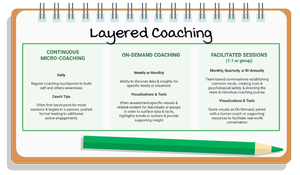
What is Micro-Coaching by Cloverleaf?
Cloverleaf’s coaching style finds its success in the digital nature of most modern businesses where new technologies combined with teamwork are the driver’s of a business’ success. Micro-coaching or continuous micro-coaching or Automated Coaching™ is the use of weekly, daily, hourly, or continual coaching in micro-doses. Think of it as small snippets of helpful information to optimize the day for success and increase the daily takeaway.
Micro-coaching, like a digital business, thrives on algorithms and data. Cloverleaf personalizes its professional development through personality tests like the Enneagram, DISC, Energy Rhythm surveys, Strengths Finder, and other metrics. These suggestions provide answers and integrate team-related content into its coaching sessions.
This small tweak to the traditional model of coaching offers new approaches for team collaboration and employee development. By providing team analysis, Cloverleaf can take the Enneagram and DISC of each member and plot them on charts to better visualize how each member learns, works, rests, and creates, allowing for a more agile and high-performing team.

HUMAN SKILL PROGRAMS ARE HITTING LIMITATIONS...
5 THINGS THIS FREE RESOURCE WILL TEACH YOU
- Close the widening gap between learning and on-the-job application
- Overcome the tension of pausing productivity for development opportunities
- Integrate learning so it is actually in the flow of work
- The evolution of human skill development
- What Automated Coaching™ is and how it works.
So what is coaching? There’s a lot of definitions out there. The way we think about coaching is there’s three key elements. One, there’s perspective. There’s someone that sits outside of your day-to-day experience that really is able to bring an outside perspective. Second element is a spark, something that ignites change moving from where you’re at today to kind of a new reality. And then the third element is action, the development component of it. So really three elements: perspective, that spark that ignites the change, and the third is achieving the best outcomes that you want for yourself.
We’re often asked, what’s the difference between coaching, mentoring, consulting, or maybe even counseling? And the way we think about that is the coach is a the thinking partner. They ask questions that lead you to self-discovery. That concept of being a partner means that they’re in it with you, not necessarily to lead or direct you and give you the answers, but more so to lead you on that path of self discovery. Three really distinct use cases for all three of those, not interchangeable. And each situation may require a mentor versus a coach or vice versa. They’re not mutually exclusive and they can be used in conjunction with each other to really support or further the learning and development process
How has coaching changed over the last few decades? Historically, coaching has been seen as a negative. I remember when I started my career, if you were being coached, that meant there was a performance issue. And that has been the historical view of coaching. You might be asking yourself, why is there suddenly an explosion of people who are entering the coaching field or have the name coach in their title? Largely that’s because there’s been a shift in how coaching is perceived in the marketplace. It’s less about the negative and working on problems and performance. Now, it’s seen as a great tool for personal and professional development. And I think as younger workers enter the workforce, the focus is more on continuous learning and continuous development. Coaching is a great tool for that.
Maybe you’ve heard the term “democratizing coaching”. How do we provide access to coaching to everyone in the organization? Coaching has primarily only been accessible to those in the top five to 10% in the organization, typically C-suite, senior and mid-level managers. If we really want to create a culture of coaching, we need to expand access to coaching to everyone in the organization. That investment seems daunting or not cost-effective. Cloverleaf is bringing Automated Coaching™ into the flow of work. This is helpful not just to expand access to coaching to everyone in the organization, but also it’s important to sustain the work that individual coaches are doing with their coaching clients when they’re not around. Typical coaching engagements are once every two weeks, once a month. What happens when that coach isn’t around? Automated Coaching™ can be the answer to bring additional facilitation and resources into the tools where clients are engaging and interacting with each other.
Often we get asked, how do we create a culture of coaching in our organization, or how do we create coaching at scale? The way we approach this is through a layered coaching concept. Obviously you can’t provide an individual one-on-one coach to everyone in the organization, but there are three key ways to creating coaching at scale across your organization.
The first, facilitated coaching. This is what we typically think of as coaching today, with either one-on-one or group facilitated conversations. In this case, a human coach works alongside these groups or individuals. The second type is on-demand coaching. This is, “Hey, I have a question.” I need access to resources to help guide us to the answers. That can come in a lot of different forms. That might look like behavioral assessment. It could be learning content. And then the third way is where Cloverleaf excels, which is Automated Coaching™. Delivering regular coaching nudges within in the flow of work. That can be accessible to everyone in the organization. There’s kind of a common framework. Cloverleaf supports all three types of coaching. We believe that every type creates a culture of coaching or coaching at scale.
Why coaching? Coaching solves a lot of team and individual employee problems. One of the common themes is interpersonal challenges. This interactivity between coworkers or team members, it shows up in a lot of different formats. What we know is that a third of a manager’s time is spent dealing with conflict. Less than a half of managers feel comfortable communicating effectively with their team members. A recent study with college students over the last three decades indicates that there’s been a 40% decline in empathy. These are all larger macro trends that point to interpersonal challenges in the workplace. Coaching is a great solution for that, especially in an Automated Coaching™ format in the tools that you use every day, how we bring together our insight into how people work.

HUMAN SKILL PROGRAMS ARE HITTING LIMITATIONS...
5 THINGS THIS FREE RESOURCE WILL TEACH YOU
- Close the widening gap between learning and on-the-job application
- Overcome the tension of pausing productivity for development opportunities
- Integrate learning so it is actually in the flow of work
- The evolution of human skill development
- What Automated Coaching™ is and how it works.


